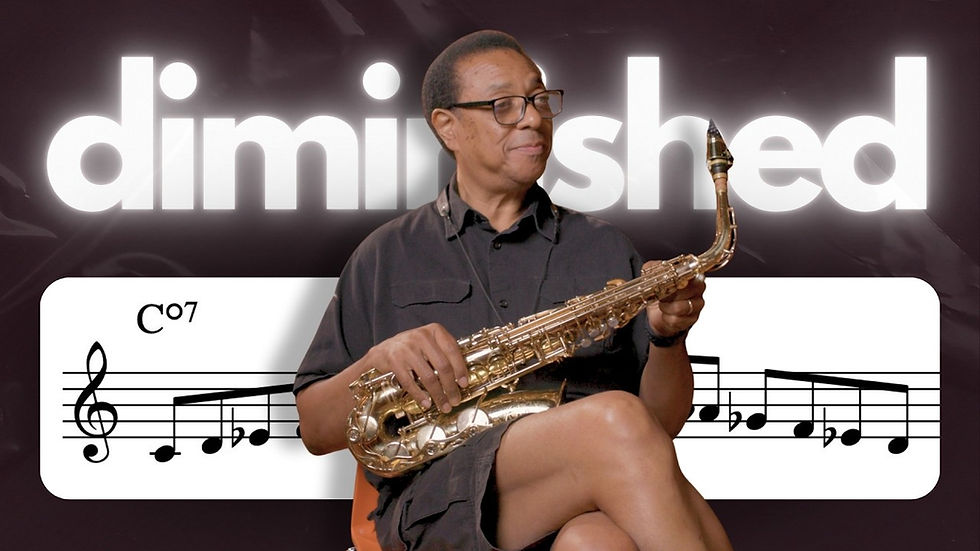How to Do More with Tritone Subs
- Jazz Lesson Videos

- Jun 30
- 3 min read
Most jazz musicians have heard of tritone substitutions, and many use them frequently. But they go way farther than just a substitution you do on a ii-V — they can be so much more.
Today we’re going to look at some different ways you can think about tritone subs, all of which come from Dr. Joe Gilman’s Jazz Theory course with Jazz Lesson Videos. If you want to see how Dr. Gilman plays through anything we talk about today, make sure to check out our accompanying YouTube video, How to Do More with Tritone Subs.
Now let’s get playing!
Contents
How to use a tritone substitution
So our basic tritone substitution is that when you have a dominant seventh chord, you can substitute a dominant seventh chord that’s a tritone away.

And this is called a tritone substitution for two reasons—the first is that the structural interval we’re talking about is a tritone, and also that we’re substituting a chord that’s a tritone away.
So if we take a ii-V-I in C major: Dm7 / G7 / Cmaj7

And then we substitute the G7 with a dominant chord that’s a tritone away, we get Db7.

So our new progression is: Dm7 / Db7 / Cmaj7
Turnarounds
Now we’re going to look at another common chord progression, something we call a turnaround. A turnaround is just what it sounds like — a series of chords that turn around back on itself to reach the original chord. The most common turnaround is a I - vi - ii - V progression.

Now because we’ve got a series of dominant chords here, we can also change all of these dominant chords to their tritone subs. Remember, the main reason you want to use a tritone sub, is if it's a dominant seventh chord that resolves down by fifth. In the case of all these secondary dominant chords, every dominant chord is resolving down by fifth, so every chord is eligible for tritone sub.

Let's tritone sub a few of these chords, E7, instead of A7 let's go to Eb7. That's its tritone sub. The next one would be Ab7— if it's going to drop down by fifth. And Db7 is also dropping down by fifth to C major. All of this is just coming from a I - vi- ii - V progression.

It’s essentially the same chord progression, just with some of these harmonic techniques added into it.

Now what happens if we take some of these tritone sub chords in this secondary dominant string, but instead of using the tritone sub, we prepare each of those chords with its respective ii, its super tonic, making a ii-V out of it?

As you know, we had an Eb7. What happens if we prepare that Eb7 with its ii? Well, if Eb7 is the V, Bbm is the ii. Later on in that tritone sub progression, we had a Db7 right at the end. So what happens if we prepare that Db7 with its ii? Well, if Db7 is the V, Abm is the ii.

Let’s take a look at that string of chords together—Bbm / Eb7 / Abm / Db7 / Cmaj7. This progression has a really outside kind of quality to it, but still supports the harmonic movement that we’re trying to create going to back to the tonic.
That’s all we have for today, but if you want to learn more about this topic and more, be sure to check out Dr. Joe Gilman’s course with Jazz Lesson Videos, as well as our accompanying YouTube video, How to Do More with Tritone Subs.
We’ll see you next time!



Out of sheer, desperate boredom, I pulled out my phone. I needed a distraction, something completely and utterly unrelated to alpacas and feelings. I scrolled through my emails, deleting junk, and one subject line caught my eye. It was from a mailing list I must have signed up for ages ago and forgotten about. It was promoting a vavada बोनस कोड for new players. The words seemed to glow on the screen, a beacon of meaningless, non-intellectual fun. It was the exact opposite of book club. It was perfect.
I clicked through. The site was bright, flashy, and made absolutely no pretensions about being high-brow. It was glorious. I entered the code, created an account, and just like that, I…